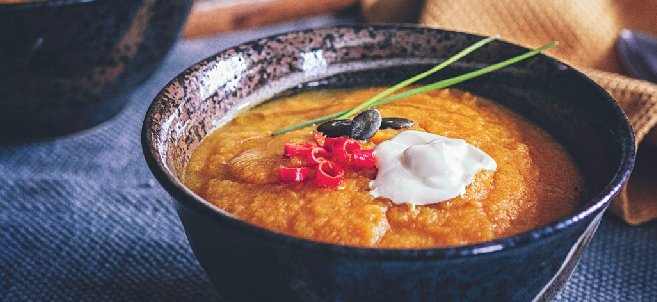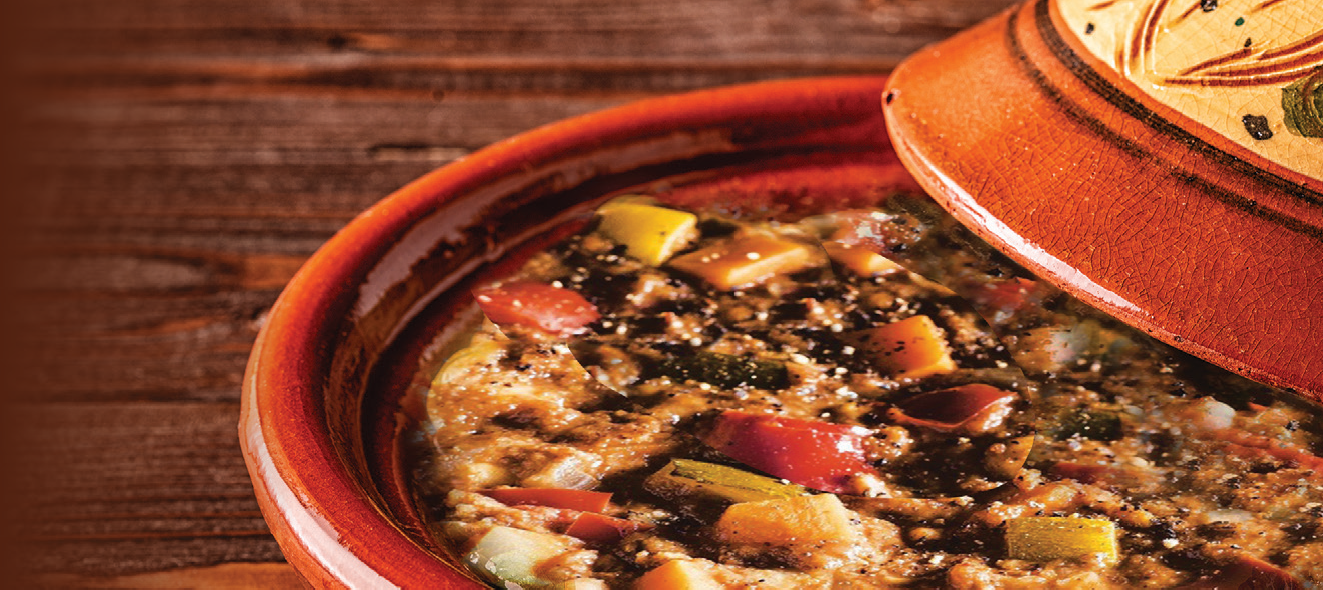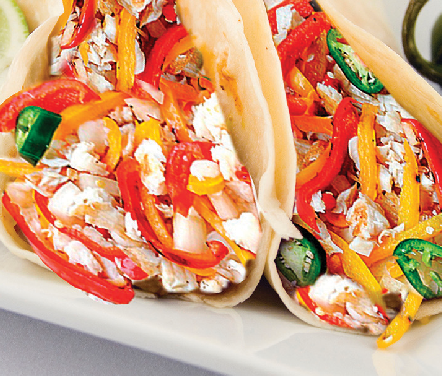The Most Powerful “Medicine” for Feeling Good May Be What You Put on Your Plate

What if you were offered a tool that was guaranteed to lift your spirits and give you the energy to do all the things you want to do?
The fact is, you already have this tool at your disposal. Numerous medical studies have found that what we eat on a daily basis is powerful “medicine”—perhaps the most powerful—for fighting depression and fatigue.
“Most people associate some kinds of food with comforts, such as pasta or ice cream,” explains Karen Basedow, MS, RD, CDE, a nutritionist for the Family Health Center outpatient clinic at Newark Beth Israel Medical Center. “But the connection between food and how we feel is much deeper than many of us know. Food actually triggers chemical reactions in our brain that lead to changes in our moods.”
How does what we eat affect the way we feel?
Food Can Reduce Depression Risk
Research shows that a higher risk of depression is linked to a diet that includes few fruits and vegetables, but lots of red or processed meat (deli meat, bacon, and hot dogs) as well as high-fat dairy products like whole milk and butter. Meanwhile, a diet that includes lots of fruits, vegetables, low-fat dairy, whole grains, fish, and olive oil is strongly associated with a much lower risk of depression.
Food Can Increase Energy
Sugary foods like soda and candy lead to a sharp surge of energy because they trigger the brain to release a feel-good chemical called dopamine. However, this so-called “sugar high” will be brief and will be followed by a slump in mood and energy levels.
On the other hand, a well-balanced diet that includes healthy fats, whole grains, lean proteins, fruits, and vegetables leads to steady levels of energy. Basedow has seen this effect in her patients. “Many who have taken our ‘vegan challenge’ and focused on a mostly plant-based diet report feeling better, more sustained energy levels,” she says.
Food Can Improve Memory and Thinking Skills
A recent large-scale study of 28,000 people in 40 different countries found that people who ate the healthiest diets were 24 percent less likely to have a decline in their thinking skills, compared with people who ate the least healthy diets.
Food Can Ease Anxiety
Certain foods spur the release of the feel-good brain chemicals dopamine and serotonin. This category includes foods rich in the nutrient magnesium, such as leafy greens like spinach and Swiss chard, as well as nuts, seeds, and whole grains. The same is true for foods rich in B vitamins, such as avocado and almonds, and foods that contain zinc, such as oysters, cashews, liver, and egg yolks.
These emotional benefits, of course, come on top of the physical benefits of a healthy diet—joints that don’t ache, fewer colds, better bowel function, lower cholesterol, reduced risk of heart and kidney disease, and much more.
Your Plate, Your Way
Good-mood meals can be created using your favorite ingredients—no matter what cuisine you like.
The eating plan most often linked to positive moods is called the Mediterranean diet, because it’s based on the traditional diet of people in areas bordering the Mediterranean Sea. But in reality, this way of eating has no geographic boundaries. “Fruits, vegetables, and fish differ from country to country, but they are just as nutritious and good for you,” says Karen Basedow, MS, RD, CDE.
The Mediterranean diet includes:
- Daily consumption of seasonal vegetables and fruits, whole grains, and healthy fats (such as those found in nuts and olive oil)
- Weekly eating of fish, poultry, beans, and eggs
- Moderate portions of dairy products
- Limited intake of red meat
The plan is easy to adapt. For example, many people of West African heritage use a lot of vegetables in favorite dishes, such as fufu, a recipe that begins with pounded yams or plantains. Beans, corn, and peppers, all Mediterranean diet staples, are common in the many Caribbean and Central American dishes. Black rice, used in many Chinese and Southeast Asian recipes, has the highest level of antioxidants (which protect cells) of all types of rice.
Find cultural flavors and whole-food ingredients in recipes from the Reverend Dr. Ronald B. Christian Community Health and Wellness Center.

Ethiopian Vegetable Stew
Based on a traditional Ethiopian recipe, this hearty dish is packed with nutrients and flavors commonly used in African dishes, including teff, a whole grain with a mild, nutty taste, that thickens the base of the stew.
Ingredients:
- 2 tablespoons olive oil
- 2 cups chopped onion
- 4 cloves garlic, minced
- 1 tablespoon berbere spice blend (purchase in an African grocery)
- 4 cups vegetable stock, low-sodium or organic
- 1 cup of water
- 1 cup uncooked teff
- 1 ¼ pound sweet potato, chopped into small cubes
- 4 tomatoes, chopped, or 1 14.5-ounce can no-salt-added tomatoes
- 8 cups collard greens
- ¼ cup natural peanut butter (containing just peanuts and salt, no sugar or added oils)
Directions:
- Place olive oil in a large stew pot. Add onion and garlic; cook until translucent.
- Add berbere spice and cook 30 seconds, stirring until combined.
- Add stock, water, teff, sweet potatoes, and tomatoes. Bring to boil, stirring occasionally.
- Cover and cook for 20 minutes, adding a little water if the stew is too thick.
- Add collard greens and simmer until wilted.
- Add peanut butter. Mix well and serve.

Coconut Pumpkin Soup
Pumpkin is used in African and some Asian cultures. In tropical locales such as Thailand or the Caribbean, coconut milk is used frequently in beverages or sauces. A number of cultures combine pumpkin and coconut in stews, rice dishes, and soups.
Ingredients:
- 1 medium orange sweet pepper, seeded and chopped
- 2 medium carrots, chopped
- 1 medium onion, chopped
- 1 tablespoon vegetable oil
- 1 14-ounce can reduced-sodium chicken broth
- 1 15-ounce can pumpkin
- 1 14-ounce can light coconut milk
- ½ teaspoon ginger or pumpkin pie seasoning
- 1 medium fresh jalapeño, seeded and finely chopped
- 2 tablespoons snipped fresh cilantro (or another seasonal fresh herb, such as sage)
Directions:
- In a large saucepan, cook sweet pepper, carrots, and onion in hot oil over medium heat for about 5 minutes, or until tender.
- In a large bowl, combine broth, canned pumpkin, and coconut milk. Stir in ginger and jalapeño.
- Add liquid ingredients to the saucepan of vegetables.
- Bring to a boil, reduce heat.
- Simmer, uncovered, 10 minutes or until heated through, stirring frequently.
- If you like a thicker soup, simmer longer to the desired thickness. Be careful to cook on low heat, checking frequently.
- Add cilantro or other garnishes to taste.

Fish Tacos With Tilapia, Peppers, and Onions
This recipe uses ingredients commonly available in the Caribbean diet—lots of fresh peppers, onions, lime, and fish combined with corn or rice and seasonings that provide a little heat, such as the jalapeño used here.
Ingredients:
- 1 white onion, sliced
- 1 red pepper, seeded and sliced
- 1 yellow pepper, seeded and sliced
- 1 orange pepper, seeded and sliced
- 1 teaspoon olive oil
- 1 tablespoon fresh chopped cilantro
- 4 tilapia fillets, 5 ounces each
- Cooking spray
- 8 6-inch corn tortillas
- 1 small jalapeño
- 1 lime, cut into 8 wedges
Directions:
- Preheat skillet on high heat with olive oil.
- Add onions and peppers and sauté on high heat until the edges of the vegetables begin to brown. Set aside in a mixing bowl.
- Spray grill pan with cooking spray and cook fish fillets until translucent, about 3 minutes each side or until fish flakes easily when tested with a fork.
- Add fish to vegetables and toss lightly.
- Warm tortillas according to package directions.
- Divide taco mixture among tortillas and garnish each tortilla with cilantro and a wedge of lime.
To learn about free healthy living and healthy eating classes at Newark Beth Israel Medical Center’s Reverend Dr. Ronald B. Christian Community Health and Wellness Center, call (973) 926-7371.